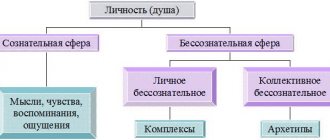Personal abilities are features of the subject’s psyche that affect the success of acquiring skills, knowledge, and abilities. However, the abilities themselves are not limited to the presence of such abilities, signs and skills. In other words, a person’s ability is a unique opportunity for acquiring skills and knowledge. Abilities are manifested only in such activities, the implementation of which is impossible without their presence. They are not found in skills, knowledge and abilities, but in the process of their acquisition and are part of the personality structure. Every person has abilities. They are formed in the process of the subject’s life activity and change together with changes in life’s objective circumstances.
List of qualities
Personality structure includes temperament, volitional qualities, abilities, character, emotions, social attitudes and motivation. And also separately the following qualities:
- Independence;
- Intellectual self-improvement;
- Communication skills;
- Kindness;
- Hard work;
- Honesty;
- Determination;
- Responsibility;
- Respect;
- Confidence;
- Discipline;
- Humanity;
- Mercy;
- Curiosity;
- Objectivity.
A person’s personal qualities consist of internal perception and external manifestations. External manifestation includes a list of indicators:
- innate or acquired artistry;
- attractive appearance and sense of style;
- oratory skills and clear pronunciation of speech;
- a competent and sophisticated approach to non-verbal communication.
The main qualities of a person (her inner world) can be classified according to a number of characteristics:
- a comprehensive assessment of the situation and the absence of conflicting perceptions of information;
- an inherent love for people;
- open-minded thinking;
- positive form of perception;
- wise judgment.
The level of these indicators determines the individual characteristics of the individual being studied.
Personality orientation, character and temperament
Taking into account the personal characteristics of a person, you can help him achieve success in life, achieve better results, and become successful in school and work. The basis of personality orientation is motivation, which implies satisfaction of needs.
Some people are quite satisfied with satisfying only physiological needs. They are characterized by inertia and unwillingness to change anything in life. This type of behavior can form a melancholic person.
Other people are interested in realizing their own creative potential, satisfying social needs for communication, social growth, which is typical for sanguine and choleric people. But the direction of personality can be coordinated, regardless of the initial temperament. You just need to act differently in each case.
Sanguine - “trust, but verify”
Sanguine people tend to get carried away and always happily respond to everything new in life. Their responsiveness and sociability become the basis for their success. But exactly until they turn into frivolity, over-communication and unreliability.
The principle of working with a sanguine person is control and verification, since he does not always fulfill what he promises. Frivolity can be harmful, so it is important for sanguine people to instill perseverance and the habit of finishing what they start.
Choleric - “not a moment of peace”
The best option for developing the personality of a choleric person is to use his vigorous energy to the fullest. Such a person must be busy all the time. His energy is enough for everything: studying, playing sports, meeting with friends, working.
As long as he is passionate, he is cheerful, achieves his goals and, most importantly, they come easy to him. If a choleric person finds himself “out of work,” he begins to demonstrate temperament, aggression, incontinence, and conflict. In a team, he may well direct his energy in a dangerous direction - to destroy the built system, so by loading him with several projects, you can avoid such a danger.
Phlegmatic - “don’t rush”
Phlegmatic people seem slow and “thick-skinned,” but at the same time they are constant, patient, and most importantly, reliable. To help a phlegmatic person show his positive qualities, he cannot be rushed. In conditions of time shortage such a person cannot work. And if you don’t push him, but give him the opportunity to work at his own pace, he will do the job perfectly.
Melancholic - “do no harm”
People around me strive to take advantage of the goodwill and ability to sympathize with melancholic people. Their gentleness and humanity are good within the family, but in society they often become victims of aggression or submit to other people's demands. Their vulnerability and shyness interfere with achieving success, so when shaping the orientation of a melancholic person, one must be careful.
Shouting, pushing, setting strict limits is not for them. The attitude should be soft, and when communicating with a melancholic person, it is important to maintain a positive attitude, since he is sensitive even to the intonation of speech.
“Contact a psychologist to analyze your team,” advises Maria Roshchina, “and distribute tasks so that all its members rush to work and want to show results.”
Structure of individual qualities
To more accurately determine the quality of a person’s personality, one should highlight its biological structure. It consists of 4 levels:
- Temperament, which includes characteristics of genetic predisposition (nervous system).
- The degree of unique mental processes that allows one to determine a person's personal qualities. The level of individual perception, imagination, manifestation of volitional signs, feelings and attention influences the achievement of results.
- The experiences of people, characterized by knowledge, abilities, capabilities and habits.
- Indicators of social orientation, including the subject’s attitude to the external environment. The development of personal qualities acts as a guiding and regulating factor of behavior - interests and views, beliefs and attitudes (state of consciousness based on previous experience, regulating the attitude and behavior of people), moral norms.
The above categories are closely related to the needs and character, abilities and egocentrism of people. The set of general indicators influences the creation of an individual personality shell.
Personal communication abilities
In the success of an individual, the determining factor is relationships and interaction with surrounding entities. Namely, communication skills. The success of the subject in professional activities and in other areas of life depends on the degree of their development. The development of such abilities in an individual begins almost from birth. The sooner a baby can learn to speak, the easier it will be for him to interact with others. The communicative abilities of subjects are formed individually for each person. The determining factor in the early development of these abilities is parents and relationships with them; later, peers become influencing factors, and even later, colleagues and one’s own role in society.
If in early childhood an individual does not receive the necessary support from parents and other relatives, then he will not be able to acquire the necessary communication skills in the future. Such a child may grow up insecure and withdrawn. Consequently, his communication abilities will be at a low level of development. The way out of this situation can be the development of communication skills in society.
Communication abilities have a certain structure. They include the following abilities: information-communicative, affective-communicative and regulatory-communicative.
The ability to start and maintain a conversation, complete it competently, attract the interest of the interlocutor, and use non-verbal and verbal means for communication are called information and communication abilities.
The ability to perceive the emotional state of a communication partner, respond correctly to such a state, and demonstrate responsiveness and respect for the interlocutor is an affective-communicative ability.
The ability to help the interlocutor in the process of communication and to accept support and help from others, the ability to resolve conflicts using adequate methods is called regulatory-communicative abilities.
Traits of people that characterize their temperament
The innate qualities of a person shape him as a social being. Behavioral factors, type of activity and social circle are taken into account. The category is divided into 4 concepts: sanguine, melancholic, choleric and phlegmatic.
- A sanguine person is a strong and balanced person who easily adapts to a new environment and overcomes obstacles. Sociability, responsiveness, openness, cheerfulness and leadership are the main personality traits.
- A melancholic person is a weak and sedentary person. Under the influence of strong stimuli, behavioral disturbances occur, manifested by a passive attitude towards any activity. Isolation, pessimism, anxiety, tendency to reason and resentment are characteristic features of melancholic people.
- Cholerics are strong, unbalanced, energetic personality traits. They are quick-tempered and unrestrained. Touchiness, impulsiveness, emotionality and instability are clear indicators of a restless temperament.
- A phlegmatic person is a balanced, inert and slow person, not prone to change. Personal indicators show how to easily overcome negative factors. Reliability, goodwill, peacefulness and prudence are the hallmarks of calm people.
What is the difference between character and temperament?
Hippocrates spoke about the differences between people, embedded deep in their nature . Back in the 5th century BC, he proposed a classification that formed the basis of the typology of temperaments generally recognized today.
Depending on the complex of mental properties of a person, four types of human temperament are distinguished.
- Sanguine . Such people are characterized by exceptional activity. They quickly respond to events happening around them and strive for frequent changes of impressions. The failures that befall them are easily overcome: they simply step over and move on. Their lives are busy, their facial expressions are expressive, in communication they strive for leadership, and their reaction often depends on external, so-called situational impressions.
- Phlegmatic . People with such a mental organization are characterized by equanimity. They are constant in everything, from the manner of communication and the prevailing mood, to life attitudes and priorities. They are persistent, resistant to stress, do not tend to show emotions, and are reserved in conversation. External influences are rarely able to make phlegmatic people lose their temper. They are not inclined to respond to new impressions and have difficulty meeting new people.
- Choleric . Energy and a desire to embrace the immensity characterize people with this type of temperament. They are prone to violent expression of emotions, quick and impetuous, their mood often changes, and they devote themselves entirely to a new task with real passion, while often quickly cooling down and losing interest. Outwardly, a choleric person can be distinguished by rapid movements and emotional speech.
- Melancholic . Their mental organization is delicate and vulnerable. These are impressionable, deeply emotional, compassionate people who have difficulty finding a common language with colleagues and peers. They prefer loneliness to communication, they take failures seriously, and analyze for a long time, trying to determine their mistakes. They react to external factors taking into account past experience. They are calm and restrained in behavior, their speech is quiet and muffled.
“People who are prone to compassion and self-sacrifice are often bullied in society,” noted psychological coach Maria Roshchina. “They don’t give change, and if they experience negative emotions, they show them by being upset and crying.” This becomes a motivating factor for the “sadist”. Therefore, in children’s groups, those children who begin to cry faster than others are more likely to suffer from the aggression of others.”
pixabay.com/
The influence of temperament on character
The characteristics of temperament do not change over the course of life, becoming the basis of character. What is given to a person by nature determines the basis of his behavior, his inclinations, things that are given to him easily and, on the contrary, difficult.
For example, a lively and sociable sanguine person calmly finds a common language with any people, but at the same time it is difficult for him to complete a monotonous project. In this case, we can talk about restlessness as a character trait.
A choleric person, as a man of action, will immerse himself in work that interests him, but one can hardly demand attention from him towards his loved ones, that is, caring. It is much more difficult for a phlegmatic person to show initiative and determination compared to a self-confident sanguine person. A melancholic person is prone to timidity and anxiety, which are very difficult for him to overcome.
The role of temperament in character
Of course, people of different temperaments can have similar character traits. But their behavior even in situations that are close in meaning will be different. For example, both a choleric person and a melancholic person may experience suspicion towards the people around them. But if a melancholic person tries to completely stop communication with a suspicious person, to isolate himself from him, then the choleric person will try to give him a chance, if this is necessary for the business.
Perseverance also manifests itself differently in people of different temperaments. If a phlegmatic person works slowly but persistently and methodically to achieve a goal, then a choleric person will try to act energetically, aggressively, often impudently, and, if necessary, go over their heads.
At the same time, a tendency towards a certain model of behavior does not mean at all that a person cannot adjust the characteristics of his personality - quite the contrary.
Fact . The ability to control manifestations of temperament becomes an indicator of the social maturity of an individual. In this case, a system of character traits developed over the years, filled with life aspirations, subjugates those manifestations of temperament that interfere with achieving goals.
pixabay.com/
Individual character traits
Character is a set of individual traits that manifest themselves in different types of activity, communication and relationships with people. The development of personal qualities is formed against the background of life processes and the type of activity of people. To more accurately assess the character of people, behavioral factors in specific circumstances should be studied in detail.
Types of character:
- cycloid – mood swings;
- hyperthymic accentuation consists of high activity and failure to complete tasks;
- asthenic – capricious and depressive personal qualities;
- sensitive – timid personality;
- hysterical - the makings of leadership and vanity;
- dysthymic – focused on the negative side of current events.
Abilities and aptitudes
Another term used by Teplov is inclinations. Propensities represent certain attitudes of a person towards an activity. “...Abilities do not exist outside of a person’s certain relationships to reality, just as relationships are realized only through certain abilities.” The above quote indicates that aptitudes and abilities are closely interrelated. Inclinations represent the motivational component of activity. Therefore, without the presence of an inclination, a certain activity may not begin, and the ability, accordingly, will not be formed. On the other hand, if there is no successful activity, a person’s inclinations will not be objectified.
Individual abilities of people
Individual psychological qualities of a person contribute to the achievement of success and excellence in a certain activity. They are determined by the social and historical practice of the individual, the results of the interactions of biological and mental indicators.
There are different levels of ability:
- giftedness;
- talent;
- genius.
The development of the algorithm of personal qualities and abilities of people is characterized by the ability to learn new things in the mental sphere. Special features are manifested in a specific type of activity (musical, artistic, pedagogical, etc.).
How individual psychological characteristics of a person manifest themselves
Psychology studies the general and individual laws of formation and development of the psyche. By the way, they are studied not only by psychology, but also by philosophy and sociology. The first (general patterns), for example, includes the theory of age-related crises, the concept of psychological defense mechanisms. The second is ideas about the formation of individual psychological characteristics. What applies to them? Individual psychological characteristics of a person include temperament, character and its individual traits, abilities, and emotional-volitional sphere.
How and in what ways are individual psychological characteristics manifested? Yes in everything. For example, how we react to certain events or how we tell a story is directly related to temperament. Choleric people give in to emotions and gesticulate a lot. Phlegmatic people are reserved, pay attention to little things, and objectively assess the situation. However, we have already gotten a little ahead of ourselves. Let's look at each of the main individual characteristics in more detail, including temperament.
Interesting! The study of individual psychological characteristics deals with a special branch of psychology - differential psychology, or the psychology of individual differences. It explains why people behave differently in the same situations, why children with completely different futures grow up in the same conditions, etc.
Strong-willed traits of people
Adjusting behavioral factors associated with overcoming internal and external discomfort makes it possible to determine personal qualities: the level of effort and plans for taking actions, concentration in a given direction. Will manifests itself in the following properties:
- willpower - the level of effort to achieve the desired result;
- perseverance – the ability to mobilize to overcome troubles;
- endurance - the ability to limit feelings, thinking and actions.
Courage, self-control, commitment are the personal qualities of strong-willed people. They are classified into simple and complex acts. In a simple case, incentives to action flow into execution automatically. Complex acts are carried out on the basis of motivation, drawing up a plan and taking into account the consequences.
How to write a term paper on speech therapy
07.09.2010 246900
These guidelines are compiled to help students gain an understanding of the content and structure of coursework in speech therapy.
Logopedia of pedagogical science that studies anomalies of speech development with normal hearing, explores the manifestations, nature and mechanisms of speech disorders, develops the scientific basis for overcoming and preventing them means of special training and education.
The subject of speech therapy as a science is speech disorders and the process of training and education of persons with speech disorders.
The object of study is a person suffering from a speech disorder.
The main task of speech therapy as a science is the study, prevention and elimination of various types of speech disorders.
Coursework in speech therapy is a student's scientific and experimental research. This type of educational activity, provided for by the educational and professional program and curriculum, contributes to the acquisition of skills in working with literature, analyzing and summarizing literary sources in order to determine the range of insufficiently studied problems, determining the content and methods of experimental research, processing skills and qualitative analysis of the results obtained. The need to complete coursework in speech therapy is due to the updating of knowledge concerning the content, organization, principles, methods and techniques of speech therapy work.
As a rule, during their studies, students must write two term papers - theoretical and practical.
The first course work should be devoted to the analysis and synthesis of general and specialized literature on the chosen topic. Based on this analysis, it is necessary to justify and develop a method of ascertaining (diagnostic) experiment.
In the second course work, it is necessary to provide an analysis of the results obtained during the ascertaining experiment, as well as determine the directions and content of speech therapy work, and select adequate methods and techniques of correction.
So, let’s present the general requirements for the content and design of coursework in speech therapy.
The initial and most important stage of working on a course project is the choice of a topic, which is either proposed by the supervisor or chosen by the student independently from a list of topics that are consistent with the areas of scientific research of the department.
Each topic can be modified, considered in different aspects, but taking into account a theoretical and practical approach. Having chosen a topic, the student needs to think through in detail its specific content, areas of work, practical material, etc., which should be reflected both in the formulation of the topic and in the further construction of the study. It should be recalled that the chosen topic may not only have a purely theoretical orientation, for example: “Dysarthria. Characteristics of the defect”, “Classification of dysgraphia”, but also take into account the practical significance of the problem under consideration, for example: “Speech therapy work on speech correction for dysarthria”. It should also be taken into account that when formulating a topic, excessive detail should be avoided, for example: “Formation of prosodic components of speech in preschoolers of the sixth year of life attending a preschool institution for children with severe speech impairments.”
The course work includes such mandatory parts as: introduction, three chapters, conclusion, bibliography and appendix.
The text of the term paper begins with the title page . An example of its design can be seen here.
Then the content of the work is given, in which the names of chapters, paragraphs, and sections are formulated in strict accordance with the content of the thesis. An example of its design can be seen here.
In the text, each subsequent chapter and paragraph begins on a new page. At the end of each chapter, the materials are summarized and conclusions are formulated.
The introduction reveals the relevance of the problem under consideration in general and the topic being studied in particular; the problem, subject, object, and purpose of the study are defined. In accordance with the goal and hypothesis, objectives and a set of research methods aimed at achieving the objectives must be defined.
The relevance of the topic lies in reflecting the current level of pedagogical science and practice, meeting the requirements of novelty and usefulness.
When defining the research problem, it is important to indicate what practical tasks it will help to implement in training and educating people with speech pathology.
The object of research is understood as certain aspects of pedagogical reality, perceived through a system of theoretical and practical knowledge. The ultimate goal of any research is to improve this object.
The subject of research is some part, property, element of an object, i.e. the subject of research always indicates a specific aspect of the object that is to be studied and about which the researcher wants to gain new knowledge. An object is a part of an object.
You can give an example of the formulation of the object, subject and problem of research:
– The object of the study is the speech activity of preschool children with phonetic-phonemic speech disorders.
– The subject of the study is the features of intonation speech of children with phonetic-phonemic speech disorders.
– The research problem is to determine effective directions for speech therapy work on the formation of intonation expressiveness of speech in the system of correctional intervention.
The purpose of the study contributes to the specification of the object being studied. The goal of any research is to solve a specific problem. The goal is specified in tasks taking into account the subject of research.
The research objectives are formulated in a certain sequence, which determines the logic of the research. The research objectives are set on the basis of a theoretical analysis of the problem and an assessment of the state of its solution in practice.
The first chapter is an analysis of literary sources, which examines the state of this problem in historical and modern aspects, and presents the most important theoretical principles that formed the basis of the study.
When writing the first chapter, you should pay attention to the fact that the text of the course work must be written in a scientific style. When presenting scientific material, it is necessary to comply with the following requirements:
– Specificity – a review of only those sources that are necessary to disclose only a given topic or solve only a given problem;
– Clarity – which is characterized by semantic coherence and integrity of individual parts of the text;
– Logicality – which provides for a certain structure of presentation of the material;
– Reasoning – evidence of thoughts (why this and not otherwise);
– Precision of wording, excluding ambiguous interpretation of the authors’ statements.
A literary review of the state of the problem being studied should not be reduced to a consistent presentation of literary sources. It should present a generalized description of the literature: highlight the main directions (currents, concepts, points of view), analyze in detail and evaluate the most fundamental works of representatives of these directions.
When writing a work, the student must correctly use literary materials, make references to the authors and sources from which the results of scientific research are borrowed. Failure to provide required references will reduce your coursework grade.
As a rule, in coursework on speech therapy, references to literary sources are formatted as follows: the number of the cited source in the general list of references is placed in square brackets. For example: General speech underdevelopment is a speech pathology in which there is a persistent lag in the formation of all components of the language system: phonetics, vocabulary and grammar [17].
When using quotations, in square brackets, in addition to indicating the source number, the page number from which this excerpt is taken is indicated, for example: Speech rhythm is based on a physiological and intellectual basis, since, firstly, it is directly related to the rhythm of breathing. Secondly, being an element that performs a communicative function, “correlates with meaning, i.e. controlled intellectually” [23, P.40].
However, course work should not be of a purely abstract nature, so you should not abuse the unreasonable abundance of citations. Quoting should be logically justified, convincing and used only when really necessary.
In the second chapter , devoted to experimental research, the organization should be described and the program of the ascertaining experiment should be presented. The survey methodology, as a rule, consists of a description of several series of tasks, with detailed instructions, visual and lexical material, the procedure for completing tasks by experiment participants, and scoring criteria. This chapter also provides a qualitative and quantitative analysis of the results obtained.
When analyzing the results of an experiment, it is necessary to use a scoring system. Examples of various criteria for quantitative and qualitative assessment are presented in the following works:
– Glukhov V.P. Formation of coherent speech in preschool children with general speech underdevelopment. - M.: Arkti, 2002. - 144 p.
– Fotekova T.A. Test methodology for diagnosing oral speech of primary schoolchildren. - M.: Arkti, 2000. - 56 p.
– Levchenko I.Yu. Pathopsychology: Theory and practice. - M.: Academy, 2000. - 232 p.
In order to visually present the results obtained during the experimental study, it is recommended to use tables, graphs, diagrams, etc. Histograms can be used in a variety of ways - columnar, cylindrical, planar, volumetric, etc. An example of the design of tables, figures, and histograms can be found here.
The third chapter provides a rationale for the proposed methods and techniques and reveals the content of the main stages of correctional work.
The conclusion contains a summary of the material presented and the main conclusions formulated by the author.
The bibliography must contain at least 25 sources. The list includes bibliographic information about the sources used in preparing the work. An example of its design can be seen here.
In the application you can present bulky tables or illustrations, examination protocols, observation records, products of activity (drawings, written works of children), notes from speech therapy classes, etc.
The volume of one course work must be at least 30 pages of typewritten text.
In general, coursework in speech therapy is the basis for a future thesis, in which the study of the begun problem can be continued, but from the standpoint of a different approach or a comparative analysis of the disorders being studied in different age categories of people with different types of speech disorders.
The content and format of theses in speech therapy can be found here.
Literature:
1. How to write a term paper on speech therapy: Methodological recommendations. Educational and methodological manual / Comp. Artemova E.E., Tishina L.A. / Ed. Orlova O.S. – M.: MGOPU, 2008. – 35 p.
2. Research work of students in the system of higher professional pedagogical education (specialty 031800 - Speech therapy). Methodological recommendations for completing the thesis / Compiled by. L.V. Lopatina, V.I. Lipakova, G.G. Golubeva. - St. Petersburg: Publishing house of the Russian State Pedagogical University named after. A. I. Herzen, 2002. - 140 p.










